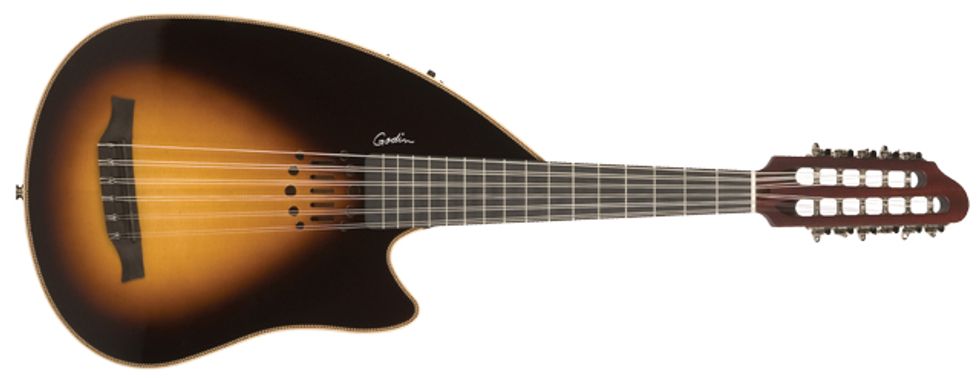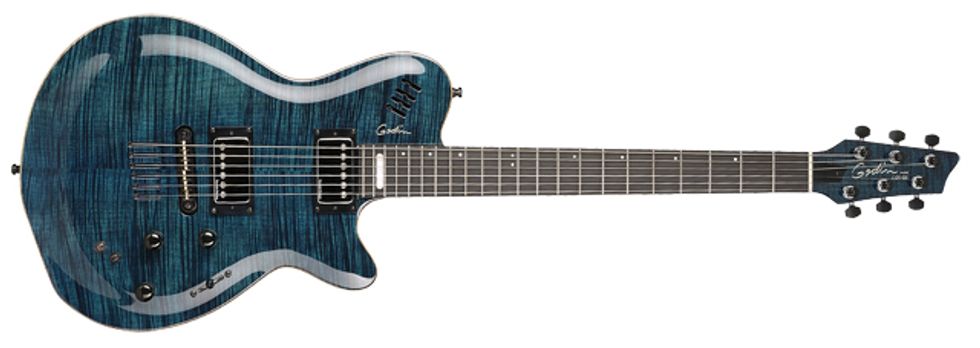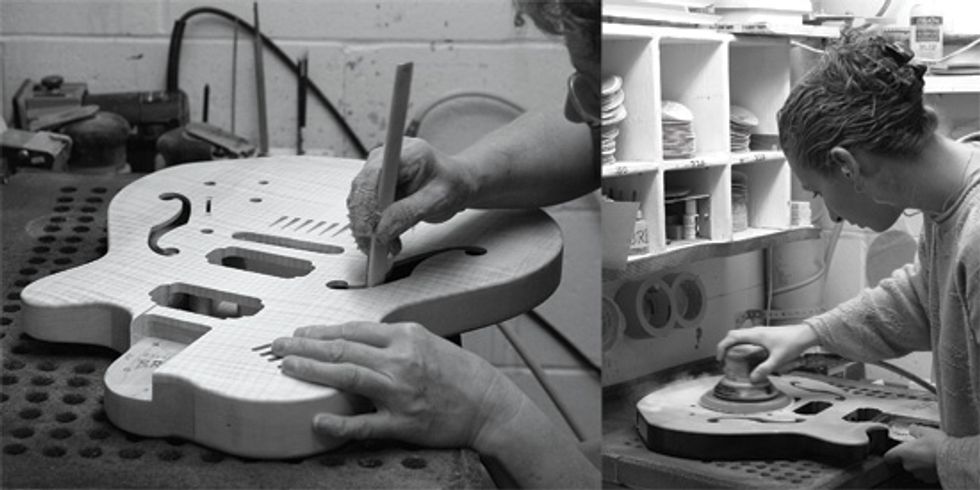By tapping into classic concepts yet constantly adding new ideas and refinements, Godin Guitars has grown into one of the largest manufacturers in North America over the last 40 years. With an annual production of 175,000 instruments across its six guitar brands—Godin, Seagull, Simon & Patrick, Art & Lutherie, Norman, and La Patrie—the company is most decidedly not a small guitar maker. Certainly not when compared to solitary luthiers toiling away in basements, attics, and backyard shops. Yet the company retains a smaller, more boutique feel as a result of its constant striving for innovation, improvement, and responsiveness to player needs. And those characteristics are a direct reflection of founder Robert Godin’s personal attitude toward instrument experimentation.
6-Point Buck or 6-String Factory?
In the early 1960s, amateur guitarists everywhere
were struggling to replicate the sounds
they heard on records. Among them was a
15-year-old Canadian named Robert Godin.
Like many others, he was fascinated by the
tones of the Ventures and the Beatles, but he
found the majority of instruments available
to him weren’t suited to those styles. While
working at Harmony Lab, a Montreal music
store, Godin began experimenting with different
string gauges, employing banjo strings on
guitars, and modifying other instrument components.
His innovations garnered praise and
word-of-mouth testimonials amongst local
guitar players. Gradually, that fan base grew to
musicians from cities all across Canada.
“He ended up becoming the place [to get mods],” says Mario Biferali, sales and marketing manager at Godin Guitars. “He had people coming from as far away as Toronto and Quebec City. Toronto is, like, five hours away! People talked, ‘Oh, there’s a place to go … he’ll make that guitar scream.’”

Godin worker Daniel Picard operating a drill press at the La Patrie guitar factory in the mid 1970s.
Godin acquired a Conn Strobotuner, a gadget that he feels was the first in Canada, and that one purchase led to a major career realization for the young luthier.
“In the old days, tuners were the size of a refrigerator and cost thousands of dollars,” says Robert Godin—still president of the company that bears his name. “I was doing intonations on guitars and realized that guitars needed many modifications to get the sound I was looking for. That’s what really got me started on my dream of creating a guitar truly built with the player in mind.”
On a hunting trip in 1972, Godin came across the factory for Norman Windows—a wooden-frame window manufacturer that, strangely enough, also dabbled in guitars. Norman’s 6-string efforts had been disappointing, but Godin became convinced he could improve the instruments. Shortly after returning home from his travels, he solidified plans to take over the factory and focus on building the guitars of his dreams.
“Everyone else on the hunting trip came home with a deer,” Godin joked in a 2011 interview with Music Trades. “I came home with a guitar factory.” To this day, the Norman guitar line still honors the window-manufacturing facility where it all started.
In It to Innovate
As you’d expect, those early years were challenging
for Godin as he loaded up a van and began crisscrossing Canada in an effort to
establish personal relationships with guitar
stores. It didn’t help that some of his ideas
were kind of out-there. In fact, from the
beginning, many of Godin’s designs have
been unusual enough that the average player
expecting traditional appointments and
construction needed to have the concept
explained in order to fully appreciate it.
For example, one of Godin’s earliest breakthroughs—using thinner finishes so that his
instruments sounded and felt livelier—was
so simple that it’s a no-brainer by today’s
standards. But back then, most instruments
featured a heavy, shiny finish that seemed to
prioritize looks over tones.
The 40th Anniversary
Acousticaster commemorates
the instrument that put Godin
on the map. It still uses the 18
tuned metal tines under the
bridge to get its unique tones,
but it’s now available with a koa
(shown) or rosewood top. Sales
and marketing manager Mario
Biferali wanted to reissue the instrument
as is, but “Robert was
like, ‘No man, let’s slap a new
pickup in there—let’s bring it
to the year 2013!’ Even when
we do something historical,
we crank it up a notch.”
“He was getting more sound out of it,” says Biferali, “but it was hard, because everybody would say, ‘Man, I love your guitars but, dude, finish that thing!’ It wasn’t shiny—it wasn’t even semi-gloss. It was literally satin [finished]. They’re walking into a guitar store, trying to sell what people thought was an unfinished guitar—but after the dealers heard the guitars, they’d be convinced.”
Those seemingly plain finishes were an early hallmark of Godin’s Seagull brand—that and the trademark narrow, tapered headstock that makes them easy to spot from a distance. Like the satin finish, the headstock shape was a practical decision: Godin chose it because it facilitates straight string pull and purportedly minimizes neck torque. He felt the latter was a particular boon due to the growing interest in alternate tunings.
Another early breakthrough was the Godin Acousticaster, which has 18 tuned metal tines mounted under the bridge to create its unusual sound. “There were a bunch of electric players that wanted an acoustic sound,” says Bifareli. “That’s how the Acousticaster differentiated itself. Here’s this thin, Telecaster-looking guitar with an electric guitar neck. But wow, it sounds acoustic when you close your eyes!” The company recently released a 40th Anniversary version of the Acousticaster that includes either a rosewood or a koa top.
Godin’s acoustic-electric Multiac
Inuk Ambiance HG features 11 strings, including
fi ve unison pairs, is derived from the
popular Multiac Multioud Ambiance Steel—which is based on the Middle Eastern oud.
Its chambered mahogany body is mated to
a solid spruce top, a mahogany neck, ebony
fretboard and bridge, and a Fishman Aura
Pro system with 3-band EQ, tuner, blend
and volume knobs, and four selectable
sound images.
Like the plainly finished and unadorned Seagull tops, the Godin Multiac series took some time to catch on among players and music-store owners. Today’s Duet Ambiance models feature Fishman Aura electronics driven by an undersaddle transducer. And the SA (synth access) models utilize an RMC Poly-Drive pickup and transducer-equipped saddles under each string. Producing a wide range of tonal options, the instruments are easily identifiable visually by the sliders and controls on the upper bout.
“Even the Multiac—one of our biggest success stories to date—wasn’t, like, an immediate ‘Okay, I get it,’” says Bifareli. “It was something that had to be explained. We did a lot of product training on it. But with the sliders on the face, that’s just logic. Why put the knobs closer to the bottom when you can keep your eyes on the knobs and the neck if they’re closer to the top?”
Over time, Multiacs have gained a solid following and are some of Godin’s most well-known guitars. And locating the controls on their upper bouts has carried over to numerous other Godin models. The design has proven so successful, in fact, that there are 23 nylon- and steel-string models in the Multiac range, including the brand’s innovative take on ouds and ukuleles.
Mondo MIDI
Today, the Godin brand arguably might
be most well known for its extensive use
of MIDI-compatible technologies and
components. Once again, this characteristic
grew out of Robert Godin’s insatiable
hunger for innovation and doing
things differently. He experimented with different woods and setups, identifying what worked well and what didn’t. For
example, the harder density of an ebony
fretboard made the fundamental note
emerge quicker, allowing it to track and be detected by the synth more efficiently. Bolton necks also proved to be more effective because they yielded less resonance—which
can often confuse a synth that’s trying to
accurately track a pitch.
The LGX-SA appeals to both
traditional S-style and LP-style fans with its
25 1/2" scale, maple-on-mahogany wood
complement, and dual Duncan humbuckers,
and to that already-potent mix it adds undersaddle
transducers and switching that yield both
impressive acoustic sounds and the ability to tap
into limitless synth-powered tones.
That heritage of solid connections to MIDI technology has become a calling card for the brand, and a reason why many guitarists continue to pick up their instruments. Steve Stevens—guitarist for Billy Idol, Kings of Chaos, and others—has used Godin for more than a decade. Today, he counts 12 Godin instruments in his collection, but it was the MIDI capability that caused him to originally approach the company at a NAMM show. Initially he was skeptical that a nylon-string guitar could track MIDI but he’d heard of the company’s instruments and introduced himself.
“I had come off the road with Vince Neil and was getting ready to do a flamenco-based record,” says Stevens, “and I needed a nylon-string guitar. But I was also going to be encompassing some dance elements and drum loops and things like that. When I found out there was a nylon guitar that I could trigger synths with, I was all over that. Having that Godin guitar really helped me do Flamenco A Go Go [Stevens’ 2000 solo album] in a big way.”
Dennis Davis, director of guitar studies and coordinator of music technology studies at Eastern Kentucky University, shares Stevens’ opinion of the unusual compositions, tones, and textures that Godin’s MIDI instruments facilitate.
For the last several years, iconic fusion guitarist John McLaughlin has favored a Godin Passion RG-2 onstage. The 25 1/2"-scale double-cutaway
features a bound spruce body with a figured-maple top, a hard-rock maple neck with a 12"-radius rosewood fretboard, the company’s Tru-Loc tremolo,
custom Godin humbuckers, and synth-access circuitry.
Genesis guitarist Daryl Stuermer onstage with his Montreal Premiere and a Multiac Nylon SA waiting in the wings (bottom right).
“Godin makes classical and jazz guitars that let me use MIDI input,” Davis says. “It’s a lot of fun to perform classical works using a piano sound or using the marimba sound or to play a jazz solo on electric guitar using a flute sound. It really changes the way I think creatively and interpretively.”
Stevens adds, “Man, their guitars are just rock solid—they’re roadworthy, and I’ve not found a company that really puts that much love and attention into the nylon-string instrument as Godin does. There are other companies that build nylon-string guitars—and some might even do MIDI—but right from the get-go, Godin put a lot of attention into nylon instruments.”
Dedicated Factories
Based entirely in North America, Godin Guitars has five factories in Quebec and one in New Hampshire. The factories are dedicated to building specific instruments entirely, as opposed to making necks in one place and bodies in another, and then assembling everything in yet another. This focus provides an overall understanding of the craftsmanship that goes into each guitar they build rather than silo-ing workers into a single component. The facilities are also located in smaller cities, which breeds more long-term employees and a family-like atmosphere.
“Some people stared with Robert 40 years ago,” says sales and marketing manager Mario Biferali. “Their wife and kids work there—it’s more of an old-school mentality where you go there, you work hard, and you build a life with this company.”
But Godin has also attracted a burgeoning following with its solidbody instruments, and it’s been energized by a number of high-profile players, including John McLaughlin, Marcus Miller, Brian May, Ritchie Blackmore, Bruce Cockburn, Peppino D’Agostino, and many more. Steve Stevens uses a 25 1/2"-scale single-cutaway LGXT with humbuckers when performing a number of Billy Idol songs live. “I use that for things like ‘Eyes Without a Face’ and ‘Flesh for Fantasy,’” Stevens says. “All my trem-bar kind of stuff.”
Daryl Stuermer, guitarist for Genesis and Phil Collins, is also a fan of the LGXT. His relationship with the brand dates back to a 2004 tour when Phil Collins’ bass player introduced him to Godin executives. Now when he hits the road, he takes the LGXT, a Godin Multiac Steel, and a Montreal Premiere. “I originally wanted a good electric guitar that would let me switch from an electric sound to a good acoustic sound,” he says. “The other bonus is that it has a 13-pin output for synth.” All the instruments remain pretty well stock to the way they are sold in the store. “I changed one LGXT and left the other one stock. It was more aesthetic than anything: I put on Schaller M6 tuners, chrome volume and tone knobs, and a chrome toggle switch. Other than that, they are fairly straight ahead.”
Canadian Ingredients and
Craftsmanship
A recent addition to Godin’s line is the
Montreal Premiere, a thinline semi-hollowbody
that takes acoustic guitar principles
and incorporates them into an electric
instrument. Many similar instruments
feature a center block of solid wood all
the way down the middle. However, the
Montreal Premiere takes Canadian wild
cherry top, back, and sides, and merges
them with a “breathe-through carved
spruce core” that only touches at the
specific pressure points demanded by structural
integrity. From a distance, the Premiere
appears to be a classy, fairly traditional
guitar. But inside, a surprising amount of
technical advancement is apparent.
“It looks like a bridge—it has these arches inside,” says Biferali. “So what happens is that there is more acoustic resonance because the air column is bigger. It’s extremely light, extremely advanced, and that’s why you can get the same dynamics as an acoustic—because your pickup is only going to get what the guitar is giving it. It’s like having a $10,000 microphone but if the singer can’t sing, it’s not going to help.”
Besides demonstrating how Godin incorporates its acoustic expertise in its electric products, the Montreal Premiere exemplifies the company’s use of local wood supplies. “Some of the wood we use to build our guitars is literally less than a kilometer from our factories,” says Bifareli. “The maple and the silver leaf and the spruce—it’s right here. Our artisans have grown up in the woods, knowing how to dry wood, knowing how to cut the wood.”
The Montreal Premiere is built within a section of the factory called the Godin Premiere Atelier—a sort of boutique shop or mini factory within the larger production facilities in Richmond, Quebec. Dedicated to achieving the heights of craftsmanship, the Atelier features a hand-selected staff of less than 10 employees identified specifically for special projects. The Passion RG-2 and RG-3 S-style instruments are also constructed in this high-end laboratory where craft takes precedence over economics.
Godin’s 40th Anniversary Party at Winter NAMM 2013. BACK (L to R): Jimmy Papadimitrios, Richard
Bunze, Norm Arduini, Janet Godin, Robert Godin, Craig Skala, Marc Lamarre, Robert Richer, Franco
Contrino, Daniel Fiocco. FRONT (L to R): Patrick Godin, Simon Godin, Katherine Calder-Becker, Fred
DiSanto, Mario Biferali.
Fundamentals and New Ground
Godin’s electric lines benefit from being
familiar, yet different. Stylistically, they’re
recognizable yet reserved and free of cliché.
The bodies—whether single-cutaway, double-cutaway, or another shape—follow lines
associated with iconic instruments, but the
brand’s new interpretations of those tried-and-true ideas have helped the company
carve out its own niche.
“When you pick up a Les Paul, you play it a certain way,” says Biferali. “And then you pick up a Tele and, all of a sudden, you think you’re in Nashville, right? With a Strat, you end up pulling out your Jimi Hendrix riffs. I find that Godin allows the artist to shine through because it doesn’t have any preconceived notions of what it is supposed to be.”
Godin works hard to strike a balance between breaking new ground while also being rooted in proven fundamentals. “We push, we push, we push, and then we reel it back in,” says Biferali.
Harkening back to the brand’s early days when Robert Godin himself was driving a van around the country, selling to guitar stores, Godin continues to listen to musician feedback and provide instruments that ignore conventional wisdom and preconceptions. After more than 50 years in the business, the man who started it all continues to be inspired to innovate by the sounds he loves from around the globe. “When I travel, I love to collect world instruments,” Godin says. “The folk instruments from all the many world cultures truly fascinate me.”














![Rig Rundown: Russian Circles’ Mike Sullivan [2025]](https://www.premierguitar.com/media-library/youtube.jpg?id=62303631&width=1245&height=700&quality=70&coordinates=0%2C0%2C0%2C0)

















